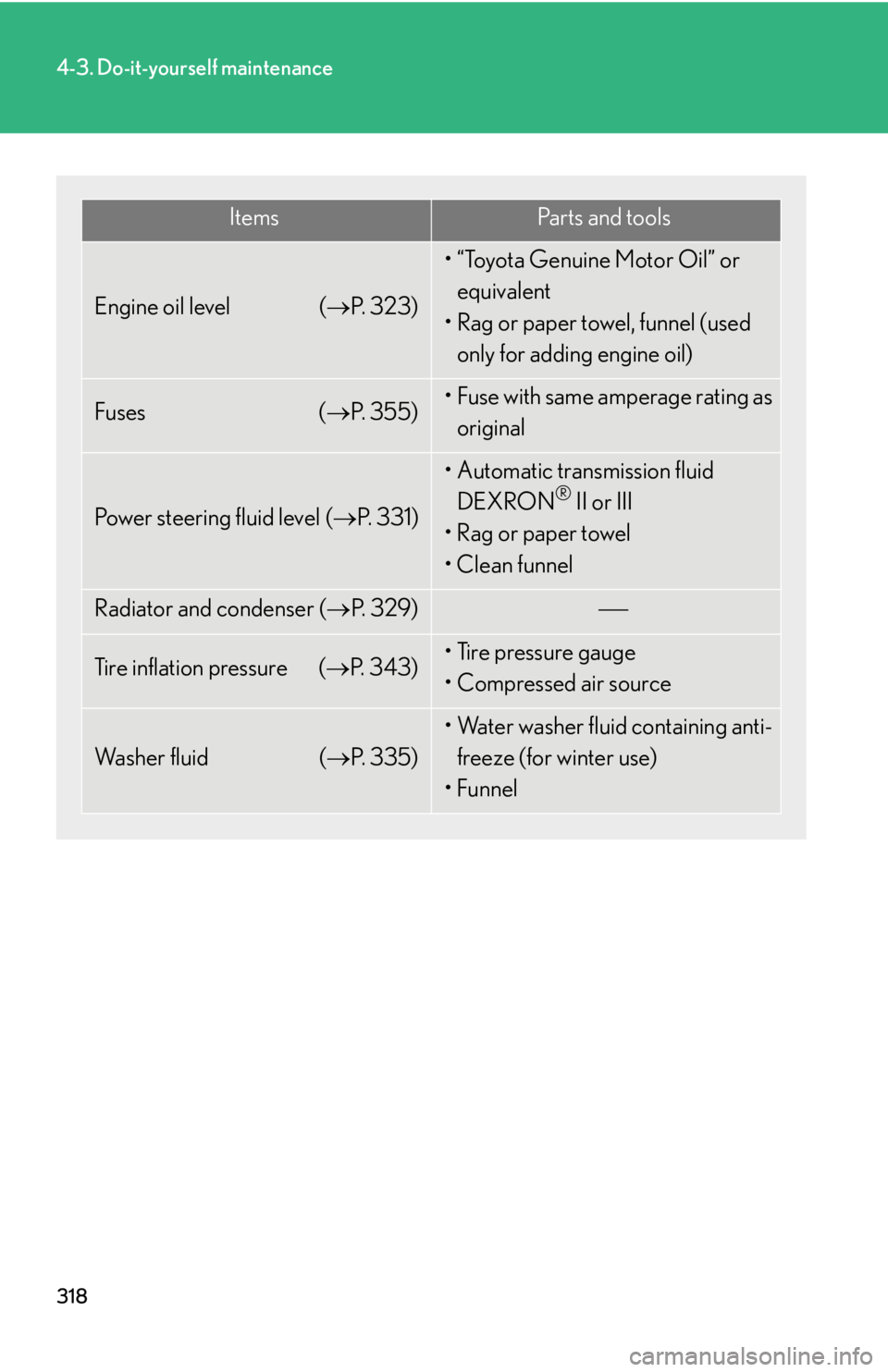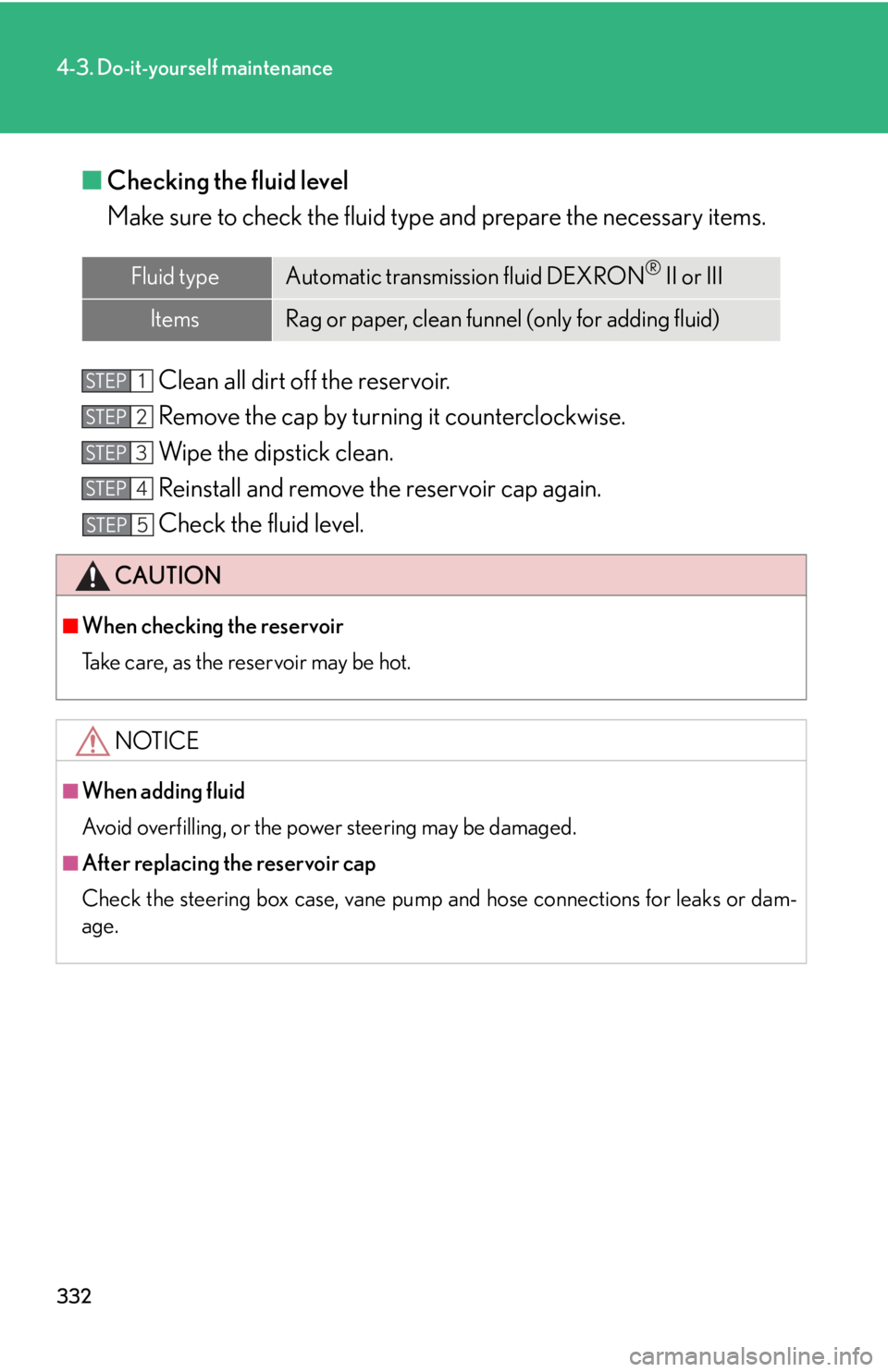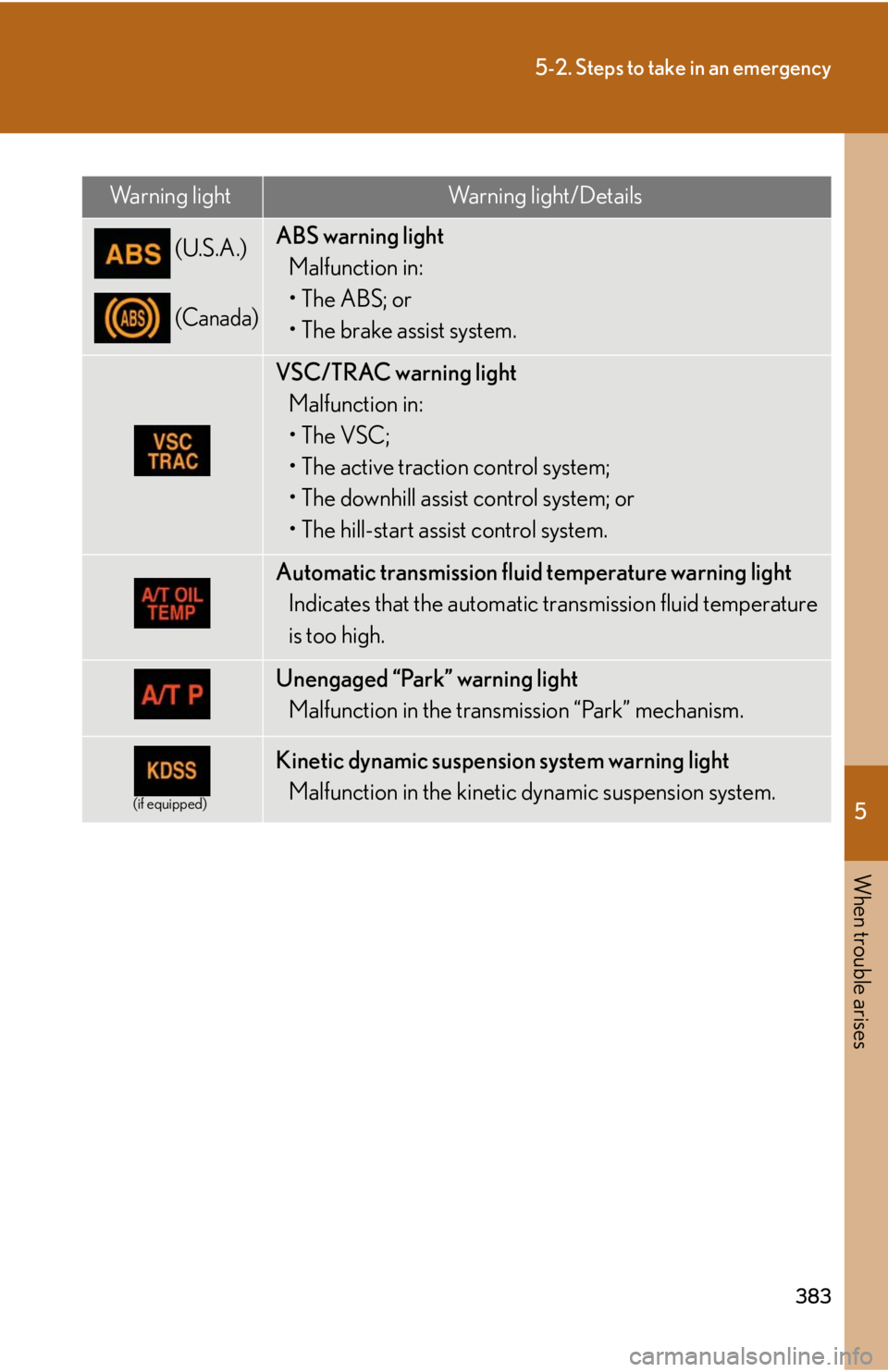transmission Lexus GX470 2008 Using other driving systems / LEXUS 2008 GX470 (OM60D82U) User Guide
[x] Cancel search | Manufacturer: LEXUS, Model Year: 2008, Model line: GX470, Model: Lexus GX470 2008Pages: 458, PDF Size: 7.3 MB
Page 189 of 458

189
2-5. Driving information
2
When driving
●Always place wheel blocks under both the vehicle and the trailer
wheels when parking. Apply the pa rking brake firmly, and put the
transmission in “P”. Avoi d parking on a slope, but if unavoidable, do so
only after performing the following:
Apply the brakes and keep them applied.
Have someone place wheel blocks under both the vehicle and
trailer wheels.
When the wheel blocks are in pl ace, release the brakes slowly
until the blocks absorb the load.
Apply the parking brake firmly.
Shift into “P” and turn off the engine.
● When restarting after parking on a slope:
With the transmission in the “P” position, start the engine. Be sure
to keep the brake pedal pressed.
Shift into “3”, “2”, “L”, or “R” position (if reversing).
Release the parking brake and br ake pedal, and slowly pull or
back away from the wheel blocks. Stop and apply the brakes.
Have someone retrieve the blocks.
CAUTION
■To avoid an accident
●Do not exceed 45 mph (72 km/h) or the posted towing speed limit, whichever is
lower. A instability (swaying) of the towing vehicle-trailer combination increases
as speed increases, exceeding 45 mph (72 km/h) may cause loss of control.
●Slow down and downshift before descending steep or long downhill grades. Do
not make sudden downshifts.
●Avoid holding the brake pedal down too long or applying the brakes too fre-
quently.
This could cause the brakes to overheat and result in reduced braking efficiency.
STEP1STEP1
STEP2STEP2
STEP1STEP3STEP3
STEP1STEP4STEP4
STEP1STEP5STEP5STEP5
STEP1STEP1
STEP2STEP2
STEP1STEP3STEP3
STEP1STEP4STEP4
Page 314 of 458

314
4-2. Maintenance
Vehicle interior
ItemsCheck points
Accelerator pedal• Moves smoothly (without uneven pedal effort or catching)?
Automatic transmission “Park”
mechanism• Can the vehicle be held securely on an incline with the shift lever in “P”?
Brake pedal
• Moves smoothly?
• Does it have appropriate clearance
and correct amount of free play?
Brakes
• Pulls to one side when applied?
• Loss of brake effectiveness?
• Spongy feeling brake pedal?
• Pedal almost touches floor?
Head restraints• Move smoothly and lock securely?
Indicators/buzzers• Function properly?
Lights• Do all the lights come on?
Pa r k i n g b r a ke
• Moves smoothly?
• Can hold the vehicle securely on an incline?
Seat belts
• Does the seat belt system operate smoothly?
• Are the belts undamaged?
Seats• Do the seat controls operate properly?
Steering wheel
• Moves smoothly?
• Has correct free play?
• No strange noises?
Page 318 of 458

318
4-3. Do-it-yourself maintenance
ItemsPa r t s a n d t o o l s
Engine oil level (P. 3 2 3 )
• “Toyota Genuine Motor Oil” or
equivalent
• Rag or paper towel, funnel (used only for adding engine oil)
Fuses ( P. 3 5 5 )• Fuse with same amperage rating as
original
Power steering fluid level ( P. 3 3 1 )
• Automatic transmission fluid
DEXRON® II or III
•Rag or paper towel
• Clean funnel
Radiator and condenser ( P. 3 2 9 )
Tire inflation pressure ( P. 3 4 3 )• Tire pressure gauge
• Compressed air source
Wa s h e r f l u i d ( P. 3 3 5 )
• Water washer fluid containing anti-
freeze (for winter use)
•Funnel
Page 332 of 458

332
4-3. Do-it-yourself maintenance
■Checking the fluid level
Make sure to check the fluid type and prepare the necessary items.
Clean all dirt off the reservoir.
Remove the cap by turning it counterclockwise.
Wipe the dipstick clean.
Reinstall and remove the reservoir cap again.
Check the fluid level.
Fluid typeAutomatic transmission fluid DEXRON® II or III
ItemsRag or paper, clean funnel (only for adding fluid)
CAUTION
■When checking the reservoir
Take care, as the reservoir may be hot.
NOTICE
■When adding fluid
Avoid overfilling, or the power steering may be damaged.
■After replacing the reservoir cap
Check the steering box case, vane pump and hose connections for leaks or dam-
age.
STEP1
STEP2
STEP3
STEP4
STEP5
Page 372 of 458

372
5-1. Essential information
If your vehicle needs to be towed
Before towingThe following may indicate a problem with your transmission. Contact
your Lexus dealer before towing.
● The engine is running, but the vehicle will not move.
● The vehicle makes an abnormal sound.
Emergency towing
If a tow truck is not available, in an emergency your vehicle may be tem-
porarily towed using a cable or chain secured to the emergency towing
eyelet. This should only attempted on hard, surfaced roads for short dis-
tances at low speeds.
A driver must be in the vehicle to s teer and operate the brakes. The vehi-
cle’s wheels, drive train, axles, steering and brakes must be in good condi-
tion.
If towing is necessary, we recommend having your vehicle towed by your
Lexus dealer or a commercial towing se rvice, using a lift-type truck or a flat
bed truck.
Use a safety chain system for all towi ng, and abide by all state/provincial
and local laws.
The wheels and axle on the ground must be in good condition.
If they are damaged, use a to wing dolly or flat bed truck.
Page 373 of 458

5
When trouble arises
373
5-1. Essential information
Towing eyelets
■Emergency towing procedureRelease the parking brake.
Put the shift lever in “N”.
The engine switch must be in the “ACC” position (engine off) or the “ON”
position (engine on).
CAUTION
■Caution while towing
●Use extreme caution when towing the vehicle.
Avoid sudden starts or erratic driving maneuvers which place excessive stress on
the emergency towing eyelet and the cable or chain.
●If the engine is not running, the power assi st for the brakes and steering will not
function, making steering and braking more difficult.
●Put the vehicle height in the “N” (normal) mode and push the height control
“OFF” switch to turn off rear height co ntrol air suspension. Otherwise the auto-
matic leveling function may adjust the vehicle height unexpectedly, resulting in an
accident.
NOTICE
■To prevent causing serious damage to the transmission
Never tow this vehicle from the rear with four wheels on the ground.
STEP1
STEP2
STEP3
Page 374 of 458

374
5-1. Essential information
Towing with a sling-type truck
Towing with a wheel lift-type truckFrom front Use a towing dolly under the rear
wheels.
NOTICE
■To prevent body damage
Do not tow with a sling type truck, either from the front or rear.
NOTICE
■To prevent causing serious damage to the transmission
Never tow this vehicle from the front with the rear wheels on the ground.
Page 379 of 458

5
When trouble arises
379
5-1. Essential information
Event data recorder
In a crash or a near car crash eventThe EDR may record some or all of the following information.
● Engine speed
● Whether the brake pedal was applied or not
● Vehicle speed
● To what extent the accelerator pedal was depressed
● Position of the transmission shift lever
● Whether the driver and front passenger wore seat belts or not
● Driver’s seat position
● Front passenger’s occupant classification
● SRS airbag deployment data
● SRS airbag system diagnostic data
Your Lexus’ Electronic Control U nit (ECU) may contain another EDR.
There are a variety of driving situation s which include activating the vehi-
cle stability control (VSC) under whic h the VSC EDR will record certain
information. The VSC EDR may record so me or all of the following infor-
mation:
● Behavior of the vehicle
● Steering wheel angle
Your vehicle has computers that monitor and control certain aspects of
your vehicle. These computers assist in driving and maintaining optimal
vehicle performance.
Besides storing data useful for troubles hooting, there is a system to record
data in a crash or a near car crash event. This is called an Event Data
Recorder (EDR).
Page 382 of 458

382
5-2. Steps to take in an emergency
Stop the vehicle immediately.The following warning indicates the po ssibility of damage to the vehicle
that may lead to an ac cident. Immediately stop the vehicle in a safe place
and contact your Lexus dealer.
Have the vehicle inspected by y our Lexus dealer immediately.
Failing to investigate the cause of the following warnings may lead to the
system operating abnormally and possibly cause an accident. Have the
vehicle inspected by your Lexus dealer immediately.
Warning lightWarning light/Details
Charging system warning light
Indicates a malfunction in the vehicle’s charging system
while the engine is running.
Low engine oil pressure warning light
Indicates an abnormal level of engine oil pressure.
This warning light may turn on if the level of engine oil
declines. The light should turn off after checking the oil and
adding oil if necessary.
Warning lightWarning light/Details
(U.S.A.)
(Canada)
Malfunction indicator lampMalfunction in:
• The electronic engine control system;
• The electronic throttle control system; or
• The electronic automatic transmission control system.
SRS warning lightMalfunction in:
• The SRS airbag system;
• The front passenger occupant classification system; or
• The seat belt pretensioner system.
Page 383 of 458

5
When trouble arises
383
5-2. Steps to take in an emergency
Warning lightWarning light/Details
(U.S.A.)
(Canada)
ABS warning lightMalfunction in:
•The ABS; or
• The brake assist system.
VSC/TRAC warning lightMalfunction in:
• The VSC;
• The active traction control system;
• The downhill assist control system; or
• The hill-start assist control system.
Automatic transmission fluid temperature warning lightIndicates that the automatic transmission fluid temperature
is too high.
Unengaged “Park” warning lightMalfunction in the transmission “Park” mechanism.
(if equipped)
Kinetic dynamic suspension system warning lightMalfunction in the kinetic dynamic suspension system.